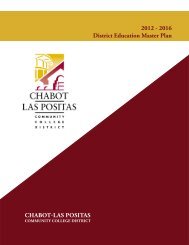City College of San Francisco - California Competes
City College of San Francisco - California Competes
City College of San Francisco - California Competes
You also want an ePaper? Increase the reach of your titles
YUMPU automatically turns print PDFs into web optimized ePapers that Google loves.
STANDARD III.A<br />
indicators that are linked to institutional effectiveness<br />
and improvement. At all levels, where<br />
employees receive a less than satisfactory rating,<br />
a remediation process has been implemented.<br />
The Board <strong>of</strong> Trustees adopted the new<br />
Administrative Evaluation and Contract Renewal<br />
Procedures at the November 2, 2002 regular<br />
Board meeting. [Ref. 4] The new process was<br />
implemented during the fiscal year 2003-04.<br />
The Administrative Evaluation process was<br />
revamped to ensure a more direct relationship<br />
between the evaluatee and his/her direct supervisor.<br />
All administrators evaluated during this<br />
cycle received ratings <strong>of</strong> satisfactory and above,<br />
and as a result there<strong>of</strong>, received three-year<br />
contracts effective July 1, 2004 through June 30,<br />
2007 1 . In general, administrators are evaluated<br />
on their performance relating to program<br />
planning, problem solving, pr<strong>of</strong>essional relationships,<br />
job knowledge and application, human<br />
resources skills, communication skills, organizational<br />
leadership skills, personal leadership skills,<br />
and teamwork. The Administrative Evaluation<br />
Oversight Committee found that the evaluation<br />
process was conducted appropriately and that<br />
reasonable input was received by the various<br />
<strong>College</strong> constituencies. For information on<br />
how the <strong>College</strong> evaluates the Chancellor,<br />
please see Standard IV.<br />
Department Chairs are evaluated in regard to<br />
the performance <strong>of</strong> their supervisory duties<br />
and responsibilities in accord with Article 8 –<br />
Evaluation <strong>of</strong> the DCC/SFCCD CBA. [Ref. 7]<br />
The Faculty Evaluation process is administered<br />
by the Office <strong>of</strong> the Dean <strong>of</strong> Curriculum, Faculty<br />
Evaluation, and Tenure Review in accordance<br />
with AFT 2121/SFCCD CBA Article 9. [Refs. 5, 8]<br />
In general, faculty are evaluated on: (1) pr<strong>of</strong>essional<br />
qualities, including keeping current in<br />
their discipline; (2) pr<strong>of</strong>essional contributions<br />
(i.e., contributions to the discipline/department/District);<br />
(3) performance—classroom<br />
instruction; and (4) classroom presentation,<br />
including demonstrating sensitivity to the<br />
learning difficulties <strong>of</strong> the student. Student<br />
evaluations are a crucial component <strong>of</strong> every<br />
evaluation <strong>of</strong> every classroom instructor. They<br />
are weighed seriously, and may serve as a revealing<br />
indicator <strong>of</strong> potential areas <strong>of</strong> concern. The<br />
“job performance” component consists <strong>of</strong> an<br />
in-depth evaluation <strong>of</strong> course content, subject<br />
knowledge and classroom presentation for<br />
classroom faculty. For librarians, job performance<br />
is evaluated in areas such as promoting student<br />
access to and use <strong>of</strong> the library, providing students<br />
with materials that are appropriate to their<br />
needs, and striving to maintain an environment<br />
conducive to study, research, reading, and learning.<br />
Counselors’ job performance is evaluated in<br />
part according to the extent to which they are<br />
able to: help students define problems, support<br />
counselees in seeking solutions to problems,<br />
provide opportunities for counselees to express<br />
concerns, etc. Resource instructors’ job performance<br />
is evaluated to a certain extent on the basis<br />
<strong>of</strong> how effectively they develop instructional<br />
resources and demonstrate sensitivity to working<br />
with faculty/students <strong>of</strong> diverse racial and ethnic<br />
backgrounds and sexual orientations. More<br />
specific evaluation components are outlined<br />
in the Faculty Evaluation and Tenure Review<br />
document available from the Office <strong>of</strong> the<br />
Dean <strong>of</strong> Curriculum, Faculty Evaluation, and<br />
Tenure Review. [Ref. 5]<br />
The Classified employee evaluation currently<br />
follows the Performance Appraisal System <strong>of</strong> the<br />
<strong>City</strong> and County <strong>of</strong> <strong>San</strong> <strong>Francisco</strong> Department<br />
<strong>of</strong> Human Resources (DHR). [Ref. 6] The purposes<br />
<strong>of</strong> the performance plan and appraisal are to:<br />
(1) evaluate the strengths and weaknesses <strong>of</strong> the<br />
employee’s work; (2) communicate these to the<br />
employee; and (3) set goals for performance,<br />
improvement, and career development. New<br />
permanent classified staff are evaluated after<br />
three months and on the anniversary date <strong>of</strong><br />
employment. The current appraisal/evaluation<br />
process does not provide for a specific rating<br />
on dedication to pr<strong>of</strong>essional growth as made<br />
evident in an employee’s contribution on<br />
District-wide committees, organizations, and/or<br />
projects (e.g., Classified Senate, Accreditation,<br />
etc.). A new SEIU Local 790/SFCCD CBA provision,<br />
Article 42.D – Impact <strong>of</strong> Provision Service on<br />
1 The second cycle, conducted during academic year 2004-05, was equally successful. The administrators received satisfactory<br />
or better ratings, and their contracts were extended from July 1, 2007 through June 30, 2008.<br />
CITY COLLEGE OF SAN FRANCISCO<br />
171







